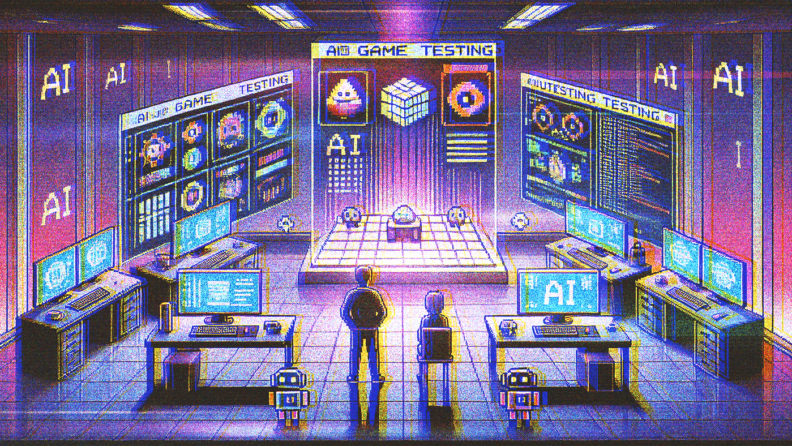Let me paint you a vivid picture: It’s the year 2014, and I’m sitting with a video game controller in my hand, my eyes bloodshot from testing the same level of a game for hours. I’m searching for bugs in every corner of the map, knowing that if I miss one, it could mean disaster for the studio.
Fast forward to today, and I couldn’t imagine testing a game in the same way. Why? Because AI and automation have stepped in, transforming video game testing from a tedious, manual slog into a fast, efficient, and smart process. And if you're still relying solely on humans to catch every bug, you’re already behind.
In this article, I'll examine how AI and automation are revolutionizing the video game testing industry. I’ll explore the new testing paradigms, how automated tools and AI systems are boosting efficiency, and why the future of game quality assurance (QA) is being built around these technologies.
The Inevitability of AI in Game Testing
Let’s face it: Developing a high-quality video game is an expensive endeavor. Video game giant Electronic Arts (EA) spent $2.453B on research and development expenses for the twelve months ending June 30, 2024, a 4.29% increase year-over-year. Regardless of the amount spent, the outcome remains unpredictable. Many video games fail, and the competition continues to intensify. This year, the biggest video game hit came from a relatively unknown Chinese video game studio.
Game development has evolved faster than many of us could have predicted. Gone are the days when QA teams could manually play through every level, check every character interaction, and test every weapon. Today’s games are immense, open-world masterpieces where the number of possible user interactions is practically infinite. Think of titles like Cyberpunk 2077 or Red Dead Redemption 2. The complexity is staggering.
The old-school method of manual testing—though still important—simply can’t keep up with the scale, variety, and complexity of modern games. It’s like trying to empty a swimming pool with a spoon. Enter AI and automation. These technologies allow us to test games at a scale and speed that humans alone could never achieve.
We need to ensure our teams have the tools they need to succeed—and AI and automation are no longer just nice-to-haves. They’re essential components of any modern game testing workflow.
10 Top AI Platforms!
Here's my pick of the 10 best software from the 10 tools reviewed.
Manual Testing Alone is Game Over
Before we dive into the benefits of AI, let’s address the elephant in the room: Manual testing. Don’t get me wrong, manual testing is crucial for many aspects of game development, especially for subjective elements like user experience, aesthetics, or narrative coherence. But when it comes to finding bugs in vast, procedurally generated worlds or simulating millions of unique user interactions, manual testing falls short.
The problem is bandwidth. No matter how skilled your QA team is, they simply don’t have the time or the resources to test every possible scenario. AI and automation fill that gap by performing tasks that would take humans days, weeks, or even months to complete in mere hours.
For example, think about testing a racing game with thousands of cars, tracks, and physics rules. A human might check the same scenario dozens of times, but an automated system can run through that scenario millions of times, each time with slightly different parameters. It’s about volume and precision, and that’s where AI shines.
4 Ways Automation Revolutionizes Game Testing
Now, let’s get into the nuts and bolts of how AI and automation are transforming video game testing. In the simplest terms, AI helps identify patterns, predict outcomes, and learn from data, while automation handles repetitive tasks that don’t require human intervention. When applied to game testing, these tools provide a powerful one-two punch that increases speed, coverage, and accuracy.
1. AI-Driven Bug Detection
One of the most frustrating aspects of game testing is tracking down bugs that only appear under very specific conditions. You know the type: that glitch where your character falls through the floor, but only if you jump in a certain spot after running for 10 minutes. AI excels in this kind of edge-case scenario.
AI algorithms are adept at analyzing vast amounts of gameplay data and detecting patterns that would be invisible to human testers. By sifting through this data, AI systems can predict where bugs are most likely to occur, allowing testers to focus their efforts more efficiently. Even better, some AI systems can automatically reproduce bugs based on this data, speeding up the debugging process significantly.
In practice, AI-powered tools like ReTest use machine learning to analyze thousands of test runs, flagging anomalies that could indicate bugs. These systems don’t just catch bugs—they learn from past tests, improving their accuracy over time.
2. Automated Playtesting
Remember those endless hours of repetitive playtesting I mentioned earlier? That’s a thing of the past thanks to automation. Automated playtesting systems can simulate human behavior and interactions across various game environments, stress-testing your game at scale. These systems can be configured to simulate thousands of different player behaviors, uncovering bugs and performance issues that may not surface during manual testing.
For example, in a large multiplayer online game, automated systems can simulate thousands of players logging in simultaneously, something that would be nearly impossible to replicate manually. Tools like GameDriver allow developers to automate these tests, ensuring that servers don’t crash under the weight of real-world player traffic.
Automation tools also help ensure consistency. Unlike human testers, who may vary in their approach, an automated system follows the same steps every time, ensuring that every build is tested under the exact same conditions.
3. AI for Balancing and Difficulty Tuning
Balancing a game—ensuring that no weapon or character is overpowered, for instance—is an art form. But it’s also a complex problem that AI is uniquely suited to solve. AI-driven tools can playtest thousands of scenarios, tweaking variables like weapon damage, character speed, and enemy AI behavior to find the sweet spot.
Take AI Dungeon, an example of how AI can adjust gameplay on the fly. It uses AI to craft storylines based on player input, dynamically adjusting the difficulty and pacing based on player decisions. Similarly, in game development, AI can dynamically adjust in-game mechanics during testing, helping developers fine-tune gameplay elements more efficiently.
4. Automating Regression Testing
Regression testing—verifying that new updates haven’t broken anything—can be a mind-numbing process. Every time you fix a bug or add a new feature, there’s a risk that something else breaks. In large games with complex codebases, this can result in an endless loop of patching and testing.
Automation simplifies regression testing by allowing developers to automatically run tests after each build. Tools like Unity Test Automation or Unreal Engine Automation can rerun predefined test cases every time there’s a new build, catching errors early before they cause larger issues. AI can even optimize these processes by identifying the most critical tests to run based on past data, saving both time and computational resources.
Automation in Game Testing: Implementation Challenges
I’ll be the first to admit that AI and automation aren’t silver bullets. While they solve many problems, they also present new challenges.
1. Data Dependency
AI relies heavily on data to learn and improve. If your test cases are limited, so is the AI’s ability to detect new bugs. This means that to fully leverage AI, you need to invest in robust data collection and ensure your AI systems have enough training data to be effective.
For example, let’s say you’re developing a SaaS platform for game developers, like a custom game engine. If your system doesn’t log every user interaction and in-game event, your AI won’t have enough context to make intelligent predictions about bugs or performance issues. It’s essential to have comprehensive data pipelines to maximize AI’s potential.
2. AI Interpretability
Another challenge is that AI models can sometimes act as black boxes—providing an answer without clearly explaining how they arrived at that answer. This lack of transparency can make debugging difficult. If your AI says there’s a bug but doesn’t offer a clear explanation, your human testers might spend just as much time hunting for the bug as they would have without AI.
That’s why it's essential to select AI tools with a strong emphasis on interpretability. You want systems that offer clear, actionable insights, not just predictions.
3. Costs and Infrastructure
Setting up AI and automation tools isn’t cheap, nor is it easy. Implementing these technologies requires investment in both hardware and skilled personnel. Depending on the size and complexity of your game, the costs can add up quickly.
However, I believe that the long-term gains far outweigh the initial investment. The ability to catch bugs earlier, reduce manual labor, and release more stable games can save studios massive amounts of time and money in the long run.
What the Future Holds
So, where are we heading? AI and automation in game testing are still evolving, but the trajectory is clear: These tools will only become more integrated into the video game testing process. I envision a future where AI doesn’t just help test games but actively contributes to their design. Imagine AI systems that don’t just find bugs but suggest gameplay improvements or automatically balance the difficulty curve.
We’re already seeing this to some extent with games like No Man’s Sky, where AI-generated content (in the form of procedural generation) plays a significant role in the game’s development. The same principles could be applied to testing—AI could help developers generate levels, characters, and quests that are optimized for both performance and player engagement.
Embrace AI and Automation Now
If you’re still on the fence about implementing AI and automation in your game testing process, let me be blunt: You can’t afford to ignore these technologies. As games continue to grow more complex and player expectations skyrocket, manual testing won’t be able to keep up. AI and automation are the keys to delivering polished, bug-free games on time and under budget.
Studios that embrace AI and automation will thrive in the coming years. Those that don’t will find themselves drowning in bugs, delays, and increasingly frustrated players. The choice is clear.
Subscribe to The CTO Club's newsletter for more AI tips, tools, and best practices.





